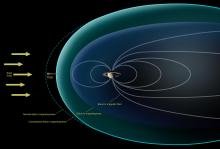Listen to today's episode of StarDate on the web the same day it airs in high-quality streaming audio without any extra ads or announcements. Choose a $8 one-month pass, or listen every day for a year for just $30.
You are here
Saturn Opposition II
It’s the start of a new season on Saturn: spoke season. Early this year, Hubble Space Telescope saw dark “spokes” in the planet’s beautiful rings. They appear to come and go with the seasons.
Saturn’s main rings span roughly three-quarters the distance from Earth to the Moon. They’re made of bits of ice, with a smattering of dust. From afar, they look smooth and even. But close-up views reveal many small features.
Some features are sculpted by small moons that orbit inside the rings. The gravity of the largest of these moons pulls at the ring particles, creating waves that ripple through the rings.
The smallest moons are only a few hundred feet across, so their gravity is weak. But it’s strong enough to create features known as propellers. These are gaps in the rings where the moonlets are, with streaks of ring material in front of and behind the moons.
The spokes appear to be unrelated to the moons. They’re clouds of dust particles that levitate above the rings. They can be thousands of miles long. The particles may get an electric charge from the solar wind, pushing them away from the rings. The spokes are most commonly seen around the equinoxes — the start of spring and fall. And the northern fall equinox is approaching — bringing “spoke season” to Saturn’s rings.
Saturn looks like a bright golden star. It’s low in the east-southeast at nightfall, and slides across the south later on.
More tomorrow.
Script by Damond Benningfield






